Busan’s vitality is best captured in markets
BUSAN -- The port city of Busan has long been a hub for exports and imports. While it relinquished its status as a gateway city to Incheon long ago, it is still a place where one can find a variety of products from in and out of the country. This has given rise to a number of large markets that draw not just merchants and shoppers but tourists too.
Here are some of the markets worth visiting in Busan.
Jagalchi Market
One of the most well-known fish markets in the country is easy enough to find: You take Subway Line No. 1 -- which also has Busan Station on it -- and get off at the creatively named Jagalchi Station, Exit No. 10. Ironically, it is not named after the jagalchi fish (Gymnelopsis brashnikovi), but got that name because the area was covered in pebbles (jagal in Korean).
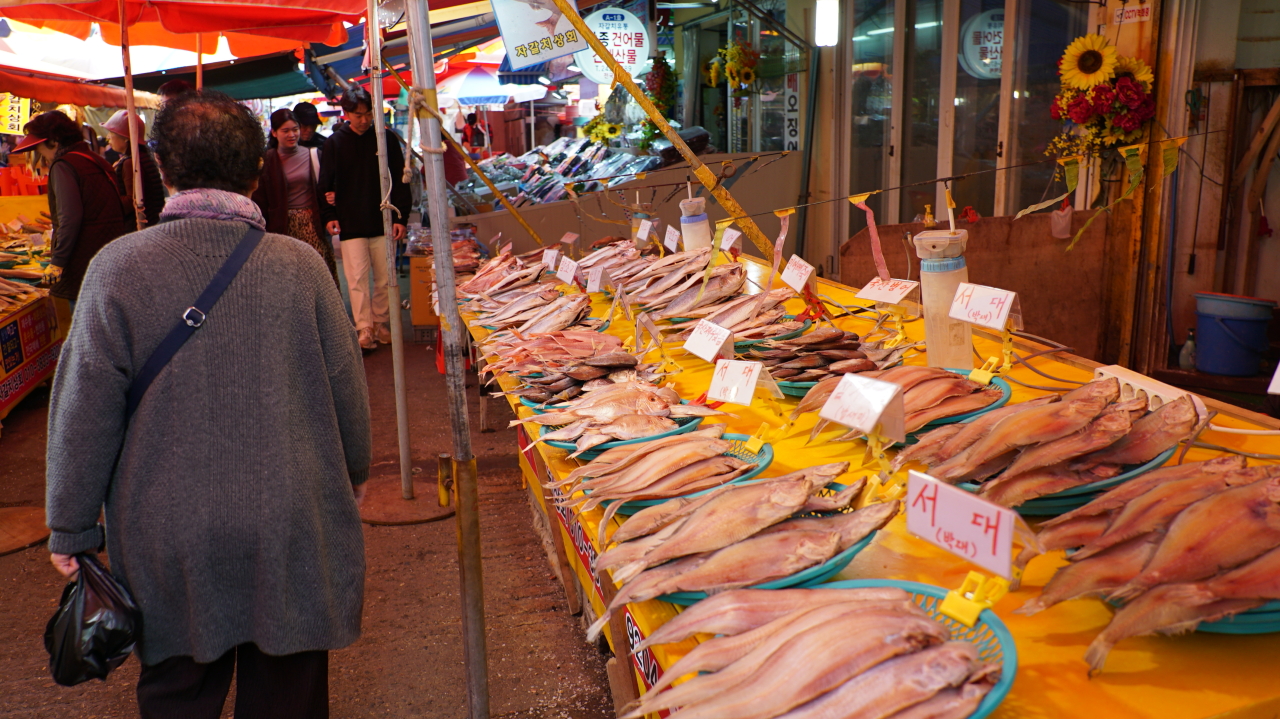 |
Jagalchi Market (Yoon Min-sik/The Korea Herald) |
Technically, the market only refers to the seven-story complex by the ocean, but people usually use the name to refer to the surrounding area too.
The first floor consists of a fish market where you can pick out your dinner, and you can decide whether you want to eat there or order the fish to go. Once you select one, and/or haggle over the price, the merchant takes out a knife and slices up the fish up front. This can be an intriguing sight, but may not for the faintest of hearts, so be warned.
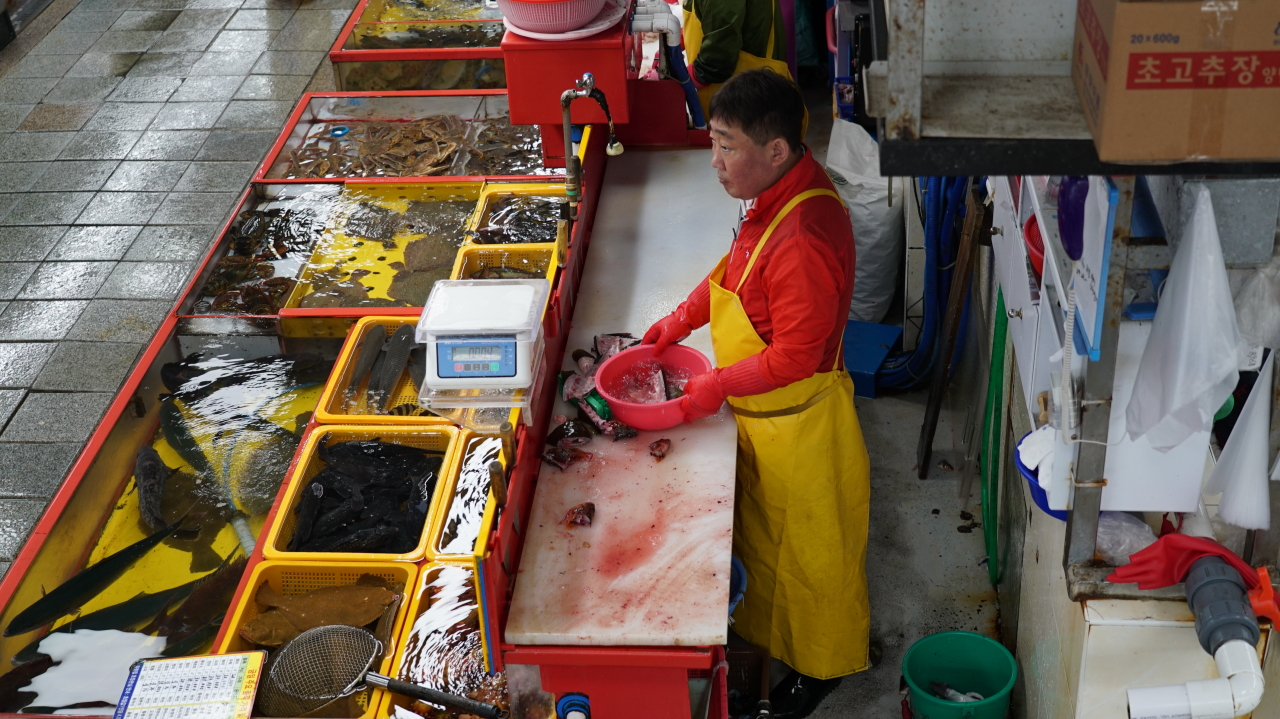 |
Jagalchi Market (Yoon Min-sik/The Korea Herald) |
Although the selection of fish there was nothing unusual, outside of sharks, rumor has it that rare types of aquatic life can be found there with luck, even a giant squid. Me, I was content with seeing a 90-centimeter tuna thrashing in a net, right in front of me.
If you decide to eat in, you will be escorted upstairs to the dining area. For an extra charge, they give you side dishes with the fish you just picked out, served in its raw state -- called hoe in Korean or sashimi in Japanese. It is quite loud and offers very little privacy, so make sure to check out the second floor before you decide to eat in.
The third and fourth floors have karaokes and offices, the fifth has a seafood restaurant, and on the seventh is an observatory along with a guesthouse. Nothing spectacular, a nice view of the ocean and the area, but it may be crowded during weekends as it is quite small.
The conventional market on the left side of the building was what I really enjoyed as an outsider. Around 100 meters of the street is jam-packed with merchants and shoppers, with merchants calling out for customers and shoppers haggling over prices.
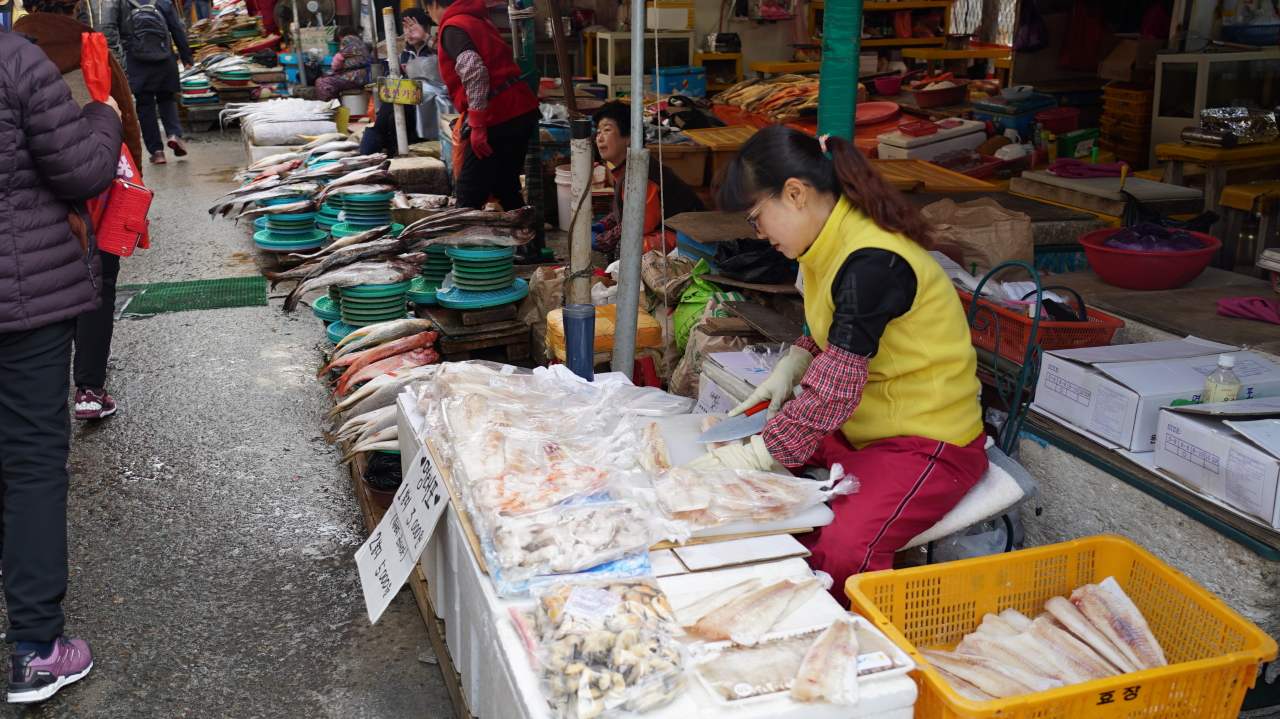 |
A woman slices up a pollack at Jagalchi Market in Busan. (Yoon Min-sik/The Korea Herald) |
If you are not a local, I would not recommend dining here as you are prone to get the tourist-exclusive price tag, but it is a great place to walk around. Even though I visited on a weekday, it was so crowded that I had but a split second to stop for a photo.
With the salty smell of the ocean in my nose, the place felt vivacious and full of life. A gentleman was chopping up a fresh cod in once place while an old lady was hanging squid on the roof for drying.
Gukje Market and Bupyeong Kkangtong (Night) Market
Gukje Market is possibly among Busan’s best-known markets to outsiders due to a hit film of the same name -- the English name for it is “Ode to My Father” -- a tearjerker set in Busan that tells the story of a man who sacrificed everything for his family.
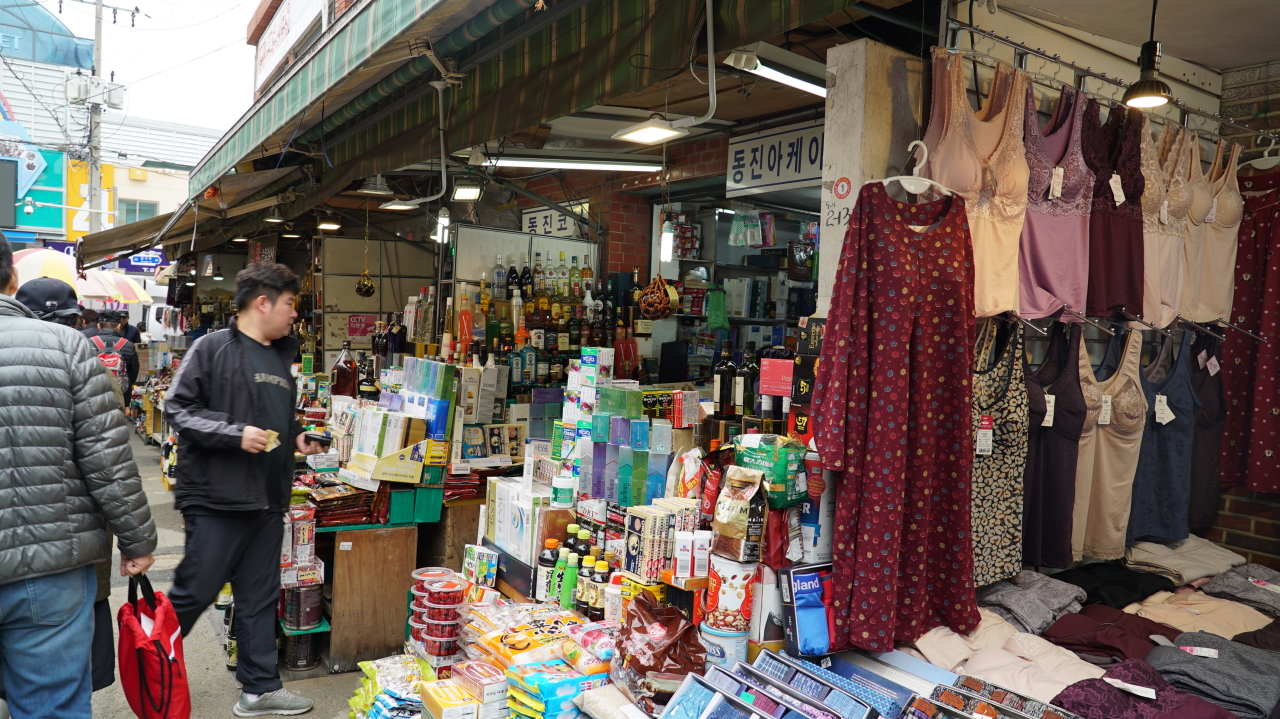 |
Gukje Market (Yoon Min-sik/The Korea Herald) |
It is one of the oldest marketplaces in South Korea, having started out as a shopping zone for the Japanese during Japan’s 1910-45 colonization of Korea. After the Korean War broke out, a huge influx of refugees and supplies flooded in.
The market is located between Nampo and Jagalchi stations, although it is a little closer to Jagalchi. It takes about 10 to 15 minutes to walk there from Jagalchi Market.
Walking there from Jagalchi would take you right through BIFF Square, named after the annual Busan International Film Festival, which wrapped up last month.
While it is still a well-known name, its status as a landmark has diminished. That’s because it is basically a street with street vendors lined up along it, and not many of them offer delicacies that are exclusive to Busan.
There was once a fad with a thing called “ssiat hotteok” -- Korean-style sweet pancakes with melted brown sugar and seeds in the middle -- flooding every corner of the square, but it looks as if BIFF Square has its best days behind it.
Since the post-movie popularity boost five years ago, it looked like Gukje Market was back to its usual state. A Wednesday visit did not result in an encounter with any kind of crowd, as most merchants sat idly by, not even attempting to call out an obvious tourist with a camera.
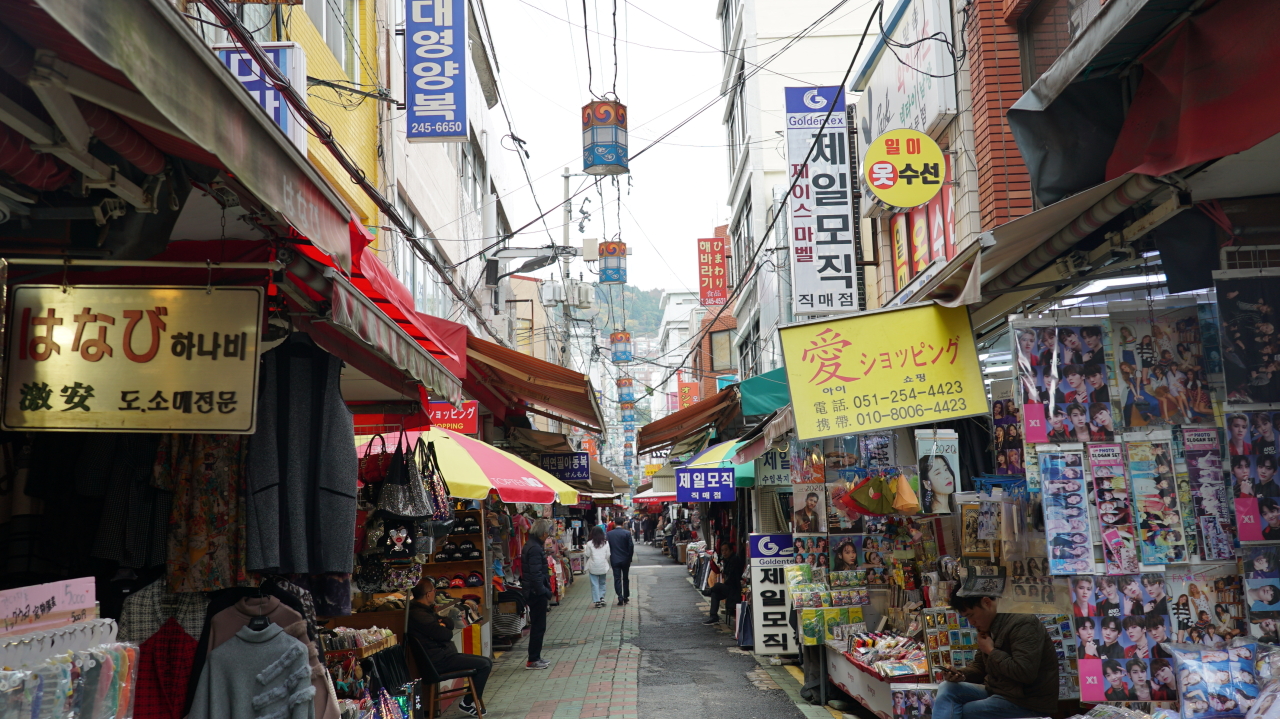 |
Gukje Market (Yoon Min-sik/The Korea Herald) |
There were a lot of shops that sold foreign products, mainly from Japan or the US, in keeping with the market’s roots. The growth of Gukje Market in the 1950s was partially due to the fact that it was where you could buy and sell supplies that had been smuggled out of US military bases, or smuggled in from Japan. Of course, the merchants now import their products legally.
Shops specializing in imported goods make up a considerable proportion of the market, including “Ggotbunine,” which became famous by being featured prominently in the 2014 film. It is not as packed with tourists now as before -- at one point, the owner had to designate a photo spot for tourists so as not to hinder business -- but it still is mentioned as a place to visit when in Busan.
One minor thing I liked about the market was a novelty hat shop with silly phrases on the front of each hat. Most were harmless like “it’s my birthday,” “the boss” and “to be rich soon,” but some were weird like “to be pretty soon,” “d--k,” “abandoned by parents.” It’s silly, but imagining a hunky dude wearing a cap that said “virgin girl” on it made me snicker.
To my surprise, the next-door Bupyeong Kkangtong (Night) market seemed livelier and more popular than its better-known neighbor. The night market is open from 7:30 p.m. to midnight, but it was pretty crowded even during the day.
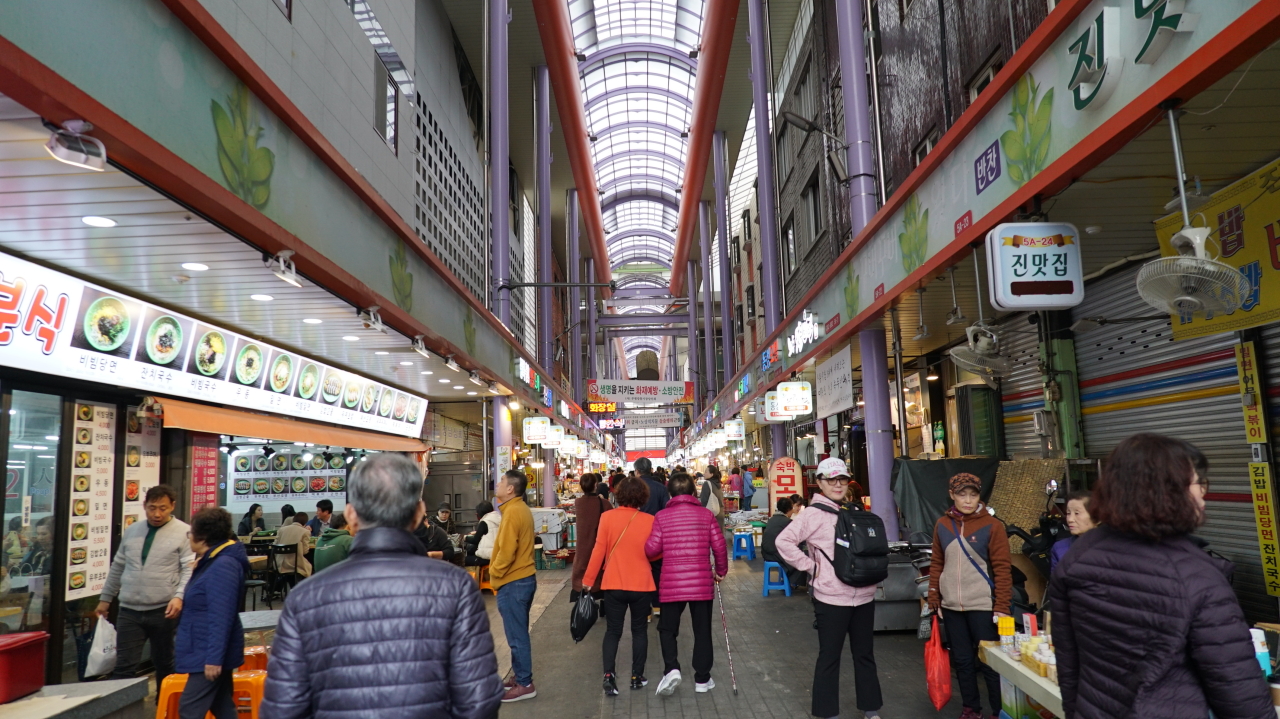 |
Bupyeong Kkangtong (Night) Market (Yoon Min-sik/The Korea Herald) |
The eatery alley is what the market is famous for, and while business usually peaks during the evening, it was very much alive at 1 p.m. as well. If you want to check out Korean street food and see what a traditional market is like, this is definitely a place worth checking out.
Bujeon Market and Choryang ArcadeBujeon Market is the largest market in Busan, comprising eight smaller markets that sell fish, vegetables, electronic devices and ginseng. It is also one of the busiest, being located in front of the Bujeon subway and train stations while being a stone’s throw away from Busan Citizens Park and the Seomyeon area, which is like Busan’s version of Hongdae.
This is another market that grew exponentially during and after the Korean War, and each section has different characteristics. I would recommend the traditional market section called Gijang Market, as the old buildings and alleyways present some of the charm that can only be gained over time.
The last place worth mentioning is the Choryang Arcade, also known as Choryang Street for Foreigners, or Texas Street, as the giant sign over the street says. It is right across the street from Busan Station, and it is not so much a market as it is a street with foreign bars, restaurants and shops.
For a street named after a US state, there were a lot of Russian joints. To be honest, it felt more like a place to booze out at night rather than a place to visit when homesick. Not much was going on during the day, but you could check out the few foreign restaurants that are open if you have the craving for it.
By Yoon Min-sik
(
minsikyoon@heraldcorp.com)













![[Today’s K-pop] Blackpink’s Jennie, Lisa invited to Coachella as solo acts](http://res.heraldm.com/phpwas/restmb_idxmake.php?idx=644&simg=/content/image/2024/11/21/20241121050099_0.jpg)